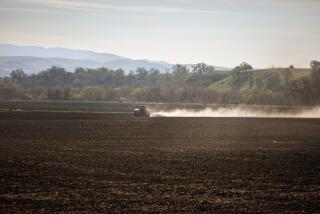Disease Traced to Extreme Weather
- Share via
An analysis of four decades of disease records from Bangladesh shows that periods of extreme rainfall, drought or high temperatures can sharply increase cholera rates, a pattern that some researchers believe bolsters claims that global warming will increase disease outbreaks.
The effect of weather on disease can be dramatic. In one period of turbulent weather from 1992 to 1994, the study found a six- to eight-fold increase in the number of cholera cases.
The study, published today in the journal Nature, found lesser increases during other periods of severe weather.
The researchers found that both floods and droughts promote cholera infections.
Floods caused by heavy monsoons often contaminate drinking water. Droughts and heat waves, sometimes caused by warming waters in the nearby Bay of Bengal, promote growth of the cholera bacterium in ponds and rivers.
Although the research does not directly address global warming, it is among the first to show that extreme weather can alter disease patterns.
“What this shows is that meteorological factors are dominant,” said Dr. Paul R. Epstein, associate director of the Center for Health and the Global Environment at Harvard Medical School. He was not involved in the study. “It’s the extremes that are bad for our health.”
Scientists have long suspected that climate variability fosters the spread of infectious diseases such as cholera, malaria and dengue fever. But firm conclusions have proved elusive because other factors, particularly migration rates and immunity from past exposure and vaccination, also have large effects.
In this case, complete demographic and disease records in Bangladesh helped investigators separate out those factors.
Cholera, a major problem in developing nations, is caused by Vibrio cholerae, a bacterium that spreads through contaminated food and water. It causes severe diarrhea, and without rapid treatment often leads to dehydration and death.
American, Spanish and Bangladeshi researchers studied the severity of cyclical cholera outbreaks in Matlab, Bangladesh, in the Ganges and Brahmaputra river deltas.
They examined disease rates and climatic conditions, including rainfall, from 1966 to 2002. The severity of cholera outbreaks corresponded to harsh conditions stimulated by El Nino, a weather pattern with global effects that stems from warming in the Pacific Ocean.
“Even when you take the degree of immunity into account, there is still solid evidence for the role of climate variability in cholera rates,” said Mercedes Pascual, an ecologist at the University of Michigan and coauthor of the study.
Systems designed to track local immunity levels, and monitor ocean temperature and rainfall, could eventually predict cholera outbreaks -- a step that could help scientists determine effects of global warming on disease patterns, she said.






